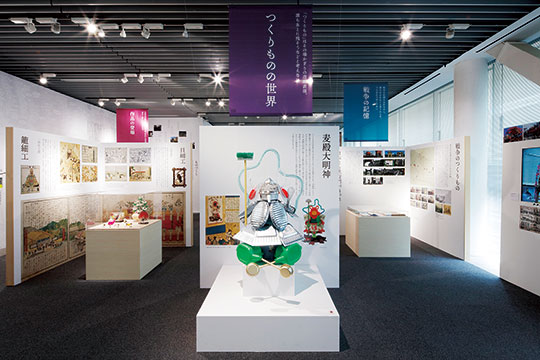建築と建物…とつくりもの
藤森照信 建築史家、建築家

木下さんとは若いころからの付き合いだが、“つくりもの”について私が考えるようになったのはそう古いことではない。もっと正確に述べれば、磯崎新から昨年、“お前の建築はつくりものダ”と次のように指摘されてから考え始めた。
「藤森照信の作る建物は伽(おとぎ)の国の魔女の栖(す)のようにみえるけれど、これはまっとうな建築史研究者が、ある日突然、気が狂ったようにつくり始めたモノだ・・・私は〈アーキテクチュア〉とは国家・都市、芸術を貫通する社会的制度だと考えております。近頃、彼は『ラ コリーナ』のような環境を取り込んだ大きいスケールの建築群を、古来日本でいいならされてきた『つくりもの』として組み立てています。いまでは能舞台に持ち込まれる移動装置の呼び方ですが、寺院の内部を荘厳にするための『かざり』をふくめ、この国ではまち、にわ、堂、祠、居、おきものすべて『つくりもの』と考えられていたのです。つまり、謎の暗号としての妙な物体が『なまもの』(植物、生きもの)まで取り込んだ『つくりもの』として出現したのです。藤森流の〈アーキテクチュア〉が出現しはじめています。ここにはさらなる謎がひそんでいる。観客になった皆さん、まずは、その暗号解読を『観察』学としてはじめてください」。
言われてはじめて気づいたが、私の建築の底には確かに“つくりもの性”が隠れている。
コンクリートや鉄のような重くて硬い材料より、木、草、土をはじめとする軽く薄い材料を好み、プロよりシロートの手の跡を大事にして仕上げをしてきた。建築思想的には今和次郎に強い親しみを覚え、バラック建築や路上観察にうつつを抜かしてきた。木下さんと若いうちから知己を得たのはバラックや路上への視点を共有していたからだ。
日本の歴史的建築への私の関心は偏りが強く、近代であれば明治の大工棟梁による擬洋風、遡れば安土桃山時代の利休の茶室、もっと古ければ縄文時代や古墳時代の建物に魅せられてきた。近年、強く関心を持ったのは奈良の春日大社で冬の暗闇のなかで行われる“若宮御祭”の時に一時的に作られる“御旅所”とその中に置かれる神霊の座所たる“つくりもの”。おそらくその延長で発生したと思われる春日造という特異な建築スタイル。
原始建築、発生期の神社建築、利休の茶室、擬洋風、今和次郎的建築、これらに共通するのはつくりもの性であることを認めざるをえないが、磯崎さんに指摘されるまでは私は別のように考えてきた。建物と建物の作り方についてより始原的なところを目ざしている、と。それも、日本だけでなく新石器時代に世界中で共通に成立していた建築の始原に立脚していると。それは20世紀のインターナショナリズムと対比的に人類最初のインターナショナリズムであると。
磯崎さんに指摘されて私も考えた。私の表現の中の建築始原性というのは日本固有のつくりもの性であり、そのままインターナショナルであるとは言えないかもしれない。
日本の建築の始原性が立脚したのは草木であり、ヨーロッパ、インド、中国が立脚したのは土石だった。このことがその後の建築の運命を分けたのではないか。
というようなことを、木下さんの“つくりもの”の一件より考え始めている。
Architecture, building and Tsukurimono
Fujimori Terunobu Architectural historian, Architect

I have known Mr. Kinoshita since we were young, but it’s not long before when I started thinking about Tsukurimono. Putting it more accurate, it started when Arata Isozaki commented that my architectural works were Tsukurimono. His comment was as shown below.
“The buildings Terunobu Fujimori designed look like dens of witches. They are products of works a respectable art history researcher all of a sudden started to create fanatically. I believe architecture is a social system running through a nation, a city and arts. Recently Fujimori has constructed a large-scale group of buildings incorporating environment in La Collina as traditional Japanese Tsukurimono (designed works). Tsukurimono is a terminology now used for mobile stage set brought on to a Noh stage. It was, however, used for all designed works such as towns, gardens, small temples, small shrines, houses and ornaments including majestic decorations in temples. In other words, strange objects as a mysterious symbol were built as Tsukurimono integrating even Namamono (plants and living entities). There is another hidden mystery. I would advise the audience to start decoding it as observation study.”
His comment helped me realize that I have preference in light and thin materials such as trees, grass and earth to heavy and hard ones such as concrete and iron. I value trace of laypersons’ work more than that of professionals in finishing my design. In terms of architectural philosophy, I feel closer to Wajiro Kon and have been hooked on temporary shelters and observation of things on or along streets. I have acquainted with Mr. Kinoshita since we share the same view on temporary shelters and streets.
I have a strong biased interest in Japanese historical architecture. I like pseudo-western-style buildings by master carpenters in Taisho era and tearooms of Rikyu in Azuchi-Momoyama era. Dating further back I have been attracted by buildings of Jomon and Kofun eras. I have been fascinated by temporary Otabisho (a place where the sacred palanquin is lodged during a festival) and the Tsukurimono, which serves as a seat for divine spirit in Otabisho during Wakamiya Festival of Kasuga Shrine in Nara in recent years. I have also enchanted with the particular architectureal style called Kasuga-zukuri in the extension of my interest mentioned above.
I cannot accept the fact that the common thread connecting ancient architecture, shrine architecture at its initial phase, tea room of Rikyu, pseudo-western-style and Wajiro Kon style of architecture is the characteristics of Tsukurimono. But I had different perspectives for my work before Isozaki made the previous comment. I think I had been trying to follow primordial architecture and ways of building them. I thought my architectural design was rooted in the very origin of architecture established in the Neolithic era not only in Japan but also ubiquitously around the globe. It was, I thought, the first internationalism of mankind in contrast to the internationalism in 20th century.
I have revisited what is the origin of my work since Isozaki indicated that. Primordaiality of my architectureal expression might be connected to the characteristics of Japanese Tsukurimono, not international one.
Primordial Japanese architecture was built with grass and trees and those of Europe, India and China were built with stones. This difference might have separated the fates of the two in later years. That is the idea I started to ponder upon with the pursuit of Tsukurimono of Mr. Kinoshita.